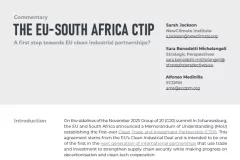In our document "A guide to climate contributions: Taking responsibility for emissions without offsetting" we aim to help address a growing demand for guidance on how companies can take responsibility for their emissions by contributing to climate action and the overarching global goals enshrined in the Paris Agreement. To address in more details some of the most frequently asked questions on climate contributions and our guidance document we set up this FAQ page.
Please click on individual questions to expand or collapse and see the respective answers.
What is a climate contribution?
Climate contributions reflect finance provided by an organisation to support climate action beyond its own value chain, without claiming to offset, or neutralise, any actual emissions. They represent a financial commitment that is a complement – and in no way an alternative – to directly reducing one’s own climate footprint.
Why take responsibility for your emissions?
Even with a robust climate strategy, companies today still release large volumes of greenhouse gas emissions into the atmosphere and will continue to on their decarbonisation paths to real zero. These emissions impose an increasingly high cost on society, the effects of which we are already seeing around the world today, and which will worsen over time. Climate costs are generally not borne by the companies, governments or individuals that are creating the emissions. Those creating the damage should also assume responsibility for it. In doing so, companies can show leadership in tackling the climate crisis and limit regulatory, commercial or legal risks to their business.
How do climate contributions differ from offsetting?
Climate contributions support global efforts to urgently tackle climate change by investing in a range of activities that have the potential to yield significant progress in decarbonising our economies. These can include projects that reduce carbon or remove it from the atmosphere, research and development of inaccessible technologies needed to sustain economic prosperity without relying on fossil fuels, or advocacy for strong climate regulation. They do not facilitate neutralising, or balancing out, actual emissions in any way.
Offsetting is a theoretical concept. It uses the purchase and retirement of a carbon credit – issued to a project judged to reduce emissions relative to a counterfactual scenario without the investment – to neutralise an entity’s actual emissions that were released into the atmosphere. An offset claim effectively advertises that the negative impact on the climate of actual emissions is balanced out by the reduction in emissions elsewhere, such that the overall effect is the same as if the emissions were never released in the first place. Offsetting is used to justify claims such as “carbon - ” or “climate neutral” or “net zero”.
Given the collective urgency to tackle climate change by reducing all emissions as fast as possible and investing in supporting others to take climate action, offset claims risk facilitating delayed action and hiding the true climate impact from key stakeholders.
Why should companies adopt the climate contribution approach?
The climate contribution approach offers companies an effective incentive to decarbonise their own value chain and powerful tool to take responsibility for the emissions they help create. And it provides their stakeholders – including customers, suppliers, investors and regulators – with a transparent, easy-to-understand metric of their climate ambitions. These are key pillars of the responsible climate strategy we set out in section 2 of the guide.
The approach provides an effective mechanism for preserving and maintaining long-term value, ensuring a competitive advantage amidst the current global climate emergency, both in terms of product offering to consumers as well as to investors. For further details, refer to section 3.3 of the guide.
What is the background to the climate contribution approach and how was it developed and used to date?
Contributing to sustainable development objectives is not new. Private sector donations towards objectives such as access to clean water, tackling disease, improving education and relieving hunger are common. And results-based finance has long been a model for investing in climate action. However, the Paris Agreement fundamentally changed the global governance of GHGs and introduced significant risks around the continued operation of traditional carbon offsetting practices.
The standard-setting body for carbon credits, Gold Standard, amongst others in the research community, recognised this and proposed a new approach modelled around climate contributions which they have championed since 2016. An assessment of the future role of the voluntary carbon market in the Paris era, identified the contribution model as the most viable approach over the long term to support efforts to address climate change, flagging many critical limitations of offsetting. NewClimate Institute’s own Climate responsibility approach set out a first application of the climate contribution model and informed the influential WWF and BCG authored Blueprint for corporate action on climate and nature. Since then, other actors such as Klarna, Spotify and DSM are applying the approach within their own businesses and at COP27, in November 2022, a decision was made by governments to label certain UN-backed carbon credits as ‘mitigation contributions’.
Can you trade climate contributions?
No. The term climate contributions simply captures the notion of a flow of finance from a company towards climate action beyond its value chain. Companies can channel this finance through tradeable certificates, such as carbon credits, but they do not have to.
How do you quantify the impact of climate contributions?
Incentivising the reduction of a company’s own value chain emissions through the application of a carbon fee is a key priority of the climate contribution approach. Companies should measure and report full value chain emissions at least on an annual basis. The company’s own progress at cutting its value chain emissions can offer insight into the impact of the approach, albeit these may also be attributable to other complementary factors, such as declining costs of lower carbon investments.
Not all climate contributions will necessarily yield carbon reductions that are straightforward to measure. Unlike offsetting, robust quantification of the climate impact of investments is less critical, and indeed this flexibility is one advantage of the approach in that it opens up options to invest in critical climate action that is less suited to measurement.
Companies should transparently communicate how (and why) they spent their money and report over time on the potential impact of their spending to the extent feasible, without making any claim of ownership over the outcomes. Impacts do not need to be uniquely expressed in terms of carbon dioxide equivalent units. Instead, they could reflect the success of research and development or policy advocacy outcomes, or the extent to which early-stage, higher-risk funding served as a catalyst for scaling up new technologies.
Why do you recommend a carbon fee over other approaches to raise contributions?
A carbon fee facilitates a number of critical elements of the responsible climate framework. It incentivises a company to prioritise reducing its own emissions, provides a tool for a company to take responsibility for the impacts it causes, and offers a transparent and unambiguous measure of a company’s level of ambition. For further details, refer to section 3.2.1 of the guide.
A carbon fee is sometimes referred to as a “money-for-tonne” or “dollar-for-tonne” approach (or similar) in that the funding is raised in direct proportional to the level of emissions. Under this approach the company sets the price level to incentivise cutting emissions within its own value chain. Alternative approaches include “tonne-for-tonne” accounting (the model adopted by those that use a carbon credit to claim to offset one tonne of carbon dioxide emissions) and “money-for-money” / “dollar-for-dollar”, where companies tie their level of funding to a financial indicator, such as their annual revenue, or profit.
A key issue with “tonne-for-tonne” account is that it is challenging, and perhaps impossible, to describe in a way which avoids any inference of offsetting. Even if the actual claims do not directly refer to offsetting, neutralising, or use related terms, at least some stakeholders are likely to interpret the approach as equivalent to offsetting. And given the premise of this approach is to match actual emissions to emission reductions or removals supported elsewhere, there is a clear incentive to channel investment towards the cheapest and most readily quantifiable mitigation options (typically via carbon credits), even if this may displace the finance of others. Refer to section 4 of the guide for further explanation on the limitations of offsetting, and section 3.2.2 on opening the pool of options to spend funds beyond those suitable for carbon crediting.
Linking the funding for climate contributions to a metric of the financial means of an organisation, through the “money-for-money” approach avoids any direct link between the company’s climate impact and the funds it then raises to take responsibility for the damage caused through its activities. It does not provide a direct price signal to incentivise reducing one’s own emissions, nor offers a transparent indication of their ambition and alignment of activities with global climate objectives. For carbon-intensive companies, this approach would allow them to continue operating in a manner that is misaligned with climate goals, without providing a strong incentive to adjust their activities and portfolio. Some argue that a “money-for-money” approach could encourage companies with relatively lower carbon intensity (and high revenues, or profits) to raise more funds for climate contributions, than under a carbon fee-type approach. However, companies could achieve the same magnitude of funding simply by applying a higher level of carbon fee, with the added advantage of then providing external stakeholders with a transparent and relatively unambiguous measure of their level of ambition.
Why do you recommend that companies channel their climate contributions to activities beyond their value chain?
Climate contributions represent a complement to both a company’s own efforts to reduce its emissions as well as the efforts of others, and not an alternative. As such the contributions should be additional to a company’s commitment to cut emissions throughout its own value chain.
In theory it may be similarly effective to channel climate contributions to particularly inaccessible, additional mitigation within a company’s own value chain as outside of it (in other companies’ value chains). However, this option would introduce a perverse incentive for companies to spend the funds on activities that they should implement anyway, undermining the overall climate impact. And crucially, it is likely impossible that external stakeholders, such as consumers, regulators or other observers, would have access to sufficient information to determine whether or not any use of climate contributions within a company’s own value chain were truly additional to investments it would anyway need to make given the carbon fee price signal.
We recommend channelling finance beyond the value chain to improve transparency, ensure an effective price signal and allow observers to scrutinise the effectiveness of the investments. Any alternative would, at best, introduce ambiguity and uncertainty on the overall legitimacy of the approach. At worst, it could undermine the approach entirely.
What claims can companies adopting the climate contribution approach make?
Companies that adopt the climate contribution approach may showcase their climate credentials, both internally, as well as externally, by referring to the level of the carbon fee they apply and its coverage, as a signal of their level of ambition. And they can describe how their climate contributions are channelled to particular initiatives which, for example, may support a country or sector on its decarbonisation pathway, or which breakdown barriers to widespread uptake of a particular technology.
In general narrative-based claims that are discursive and presented with relevant context are likely to be more credible and avoid misleading customers, investors or regulators in a way which might undermine progress in tackling climate change. In particular, companies should strive to avoid ambiguity in the interpretations of their claims.
In contrast, companies should steer clear of making short, incomplete, headline claims. Critically, companies adopting the approach should not make claims which imply any of their emissions are offset either now, or in the future. Claims such as “carbon-” or “climate neutral”, or “net-zero” emissions, amongst other related terms, all imply that actual emissions released into the atmosphere are somehow neutralised, through the concept of offsetting. These are not part of the responsible climate framework we set out in our guide. For further details, refer to section 5 of the guide.
Could discouraging offsetting have a detrimental impact on the availability of climate finance?
Climate finance covers a broad spectrum of investments – from private and public sources – to support the mitigation of climate change and our adaptation to a warming planet. Today, carbon credits – a key vehicle for those that claim to offset their emissions – represent a very small fraction of the total pool of investments channelled into decarbonising the global economy. And recent analysis highlights major question marks over how much of the finance spent on carbon credits actually reaches the climate projects and local communities they purport to support, rather than profiting market intermediaries.
Offsetting is not a substitute for delivering actual emission reductions and it does not currently offer companies compelling incentives to reduce their own emissions and invest in sustainable business practices. Investing in these own emission reductions throughout company supply chains is a critical priority of the climate contribution approach and a key driver of climate finance. Offsetting instead risks undermining the flow of climate finance by delaying action, known as the ‘substitution effect’.
In terms of spending on carbon credits, despite growth in the past years in the demand for credits, data on voluntary retirements analysed by Allied Offsets indicate global demand of approximately 200 million carbon credits in 2022 (similar to 2021 levels). These credits, even if they were all to represent a permanent reduction of one tonne of carbon dioxide, are equivalent to the emissions of a 1 gigawatt (GW) coal-fired power plant over its 30 year lifetime. For context, Global Energy Monitor data shows there are approximately 2,000 GW of coal plant currently in operation around the world with a further 500 GW under construction, or at earlier stages of development.
A shift from today’s prevailing narrative of offsetting emissions towards making climate contributions is unlikely to cut climate finance channelled through carbon credits. Instead, through pricing emissions at an appropriately high level, our recommendations on the climate contribution approach provide an opportunity to raise materially higher funding for climate action, either through procuring carbon credits or investing in a broader pool of initiatives. And, in terms of spending the funds, a shift away from offsetting can facilitate targeting the so-called ‘high-hanging fruit’, which can improve the effectiveness of climate finance by avoiding displacing the finance of other private or public actors and ensure that it does not create perverse incentives for governments to weaken their pledges or regulations.
For further details, refer to sections 3 and 4 of the guide.
Why do we need an alternative approach to offsetting?
An offset claim effectively advertises that the negative impact on the climate of actual emissions is balanced out by the reduction in emissions elsewhere, such that the overall effect is the same as if the emissions were never released in the first place. However, the theory underlying the concept no longer holds up and offsetting does not align with the goals of the Paris Agreement. While it may have offered some partial successes in the past, using carbon credits to offset emissions elsewhere – effectively a zero-sum transfer from one place to another – is not enough to address the urgent need for decarbonisation.
Where offsetting is used as a substitute for cutting own emissions, it can delay climate action and mislead a range of stakeholders. Faced with reputational and increasingly legal risk, a number of companies and intermediaries are moving away from the traditional model of offsetting emissions and demanding an alternative to take meaningful responsibility for their emissions.
For further details on the limitations of offsetting, refer to section 4 of the guide.
Can companies adopting the climate contribution approach claim they, or their brands, are climate neutral?
No. Companies could only claim they are climate neutral if the activities throughout their full value chain genuinely have no impact on the climate, i.e. their climate footprint is zero. This is inconceivable for any organisation today, or in the foreseeable future.
If climate contributions are channelled to low-impact initiatives, is this any different to offsetting with low-quality carbon credits?
Yes, there is a fundamental difference. Whilst both approaches may result in poor allocation of limited resources for driving ambitious climate action, if you claim that your emissions are offset with low-quality carbon credits that do not provide an appropriate guarantee to counterbalance the emissions actually released into the atmosphere, you are misleading a range of stakeholders about the true impact of your activities. An offsetting claim that lacks integrity can risk delaying structural change in consumer demand, investment signals and regulation related to the company’s own emissions, all of which are critical decarbonisation drivers. So, whilst the impact from the use of the funds would potentially be the same under the two approaches, the offsetting claim could negate, or undermine, any impact on the company’s own emissions.
For further details on the limitations of offsetting, refer to section 4 of the guide.
Are there examples of companies that are currently implementing the climate contribution approach?
A limited number of companies adopt the climate contribution approach today, in certain forms, with indications that more are following. The financial services provider Klarna applies a carbon fee to its emissions and set up the Milkywire Climate transformation fund as a vehicle to channel its climate contributions without any offsetting. Additional companies, including Spotify, now also contribute to the fund. NewClimate Institute also implements the model through its Climate Responsibility Approach, currently applying a carbon fee of 120 EUR to its full climate impact and channelling funds to selected ‘high-hanging fruit’ initiatives.
Other organisations are championing making climate contributions, instead of offsetting, within their climate strategies, albeit without following all of the recommended steps within our guide. Examples include Tomorrow Bank, DSM, and Stripe.
A number of other developments appear to indicate a general pivot away from offsetting towards the approach. At COP 27, in November 2022, a decision was made by governments to label certain UN-backed carbon credits as ‘mitigation contributions’ where they support a country to achieve its national target and cannot be used to offset emissions. Shortly after followed an announcement by the business consultancy, myclimate, that it would no longer offer its ‘climate neutral’ label because it is not aligned with the Paris Agreement, instead offering a new ‘climate impact’ label.






